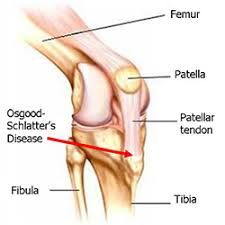Have you been told that your child has Osgood Schlatter’s disease? If you have been to your GP who has told you that your child’s pain in the front of their knee is due to Osgood Schlatter’s, then we’re here to help! There’s a good chance that your child was told to rest during times of flare ups, but there is more that can be done.
What is it anyways?
Osgood Schlatter’s is one of the most common causes of knee pain in children. It occurs during their growth spurt between the ages of 9 and 14. It is due to swelling and irritation of the growth plate (area of bone that grows) at the top of the shinbone. During growth spurts, bones, muscles and tendons grow at different rates. This can cause pulling of the tendon on the growth plate and can cause pain just below the kneecap where the tendon attaches to the bone. It is often worse with sport especially with running, jumping and going up/down stairs/hills.
What can be done?
The good thing is that your child will often grow out of this once he or she is done growing. They can sometimes be left with a larger than normal bump just below the knee where the bone has grown bigger from pulling of the tendon. This can sometimes be sore after kneeling on it.
- When he or she is in pain, ice for 5 to 15 minutes, 2 to 3 times per day
- Modify activity when he or she is having more pain (likely due to a growth spurt)
- Some pain is OK, but if it causes he or she to limp, they need to stop
- Their pain should get better with one day rest, if it continues longer they need to dial back their activity
- Use a foam roller on the quadricep muscle (muscle on the front of the thigh) to help decrease trigger points (knots) in the muscle
- Do not overstretch the quadricep muscle especially when the knee is irritated as this can cause symptoms to get worse by putting strain on the tendon’s attachment onto the bone
How can physiotherapy help?
- Help with activity modification to make sure it is not aggravating and allowing appropriate recovery between sport
- Appropriate strengthening to help decrease pain and minimize flare ups
- Identifying other contributing factors. For example, weakness and poor muscular control in the hips and feet can cause excessive loading onto the knee. Rehabilitation exercises can help to correct these
- Appropriate stretches when pain free
- Massage and dry needling to the quadriceps and associated muscles
- Taping to decrease load onto the knee

